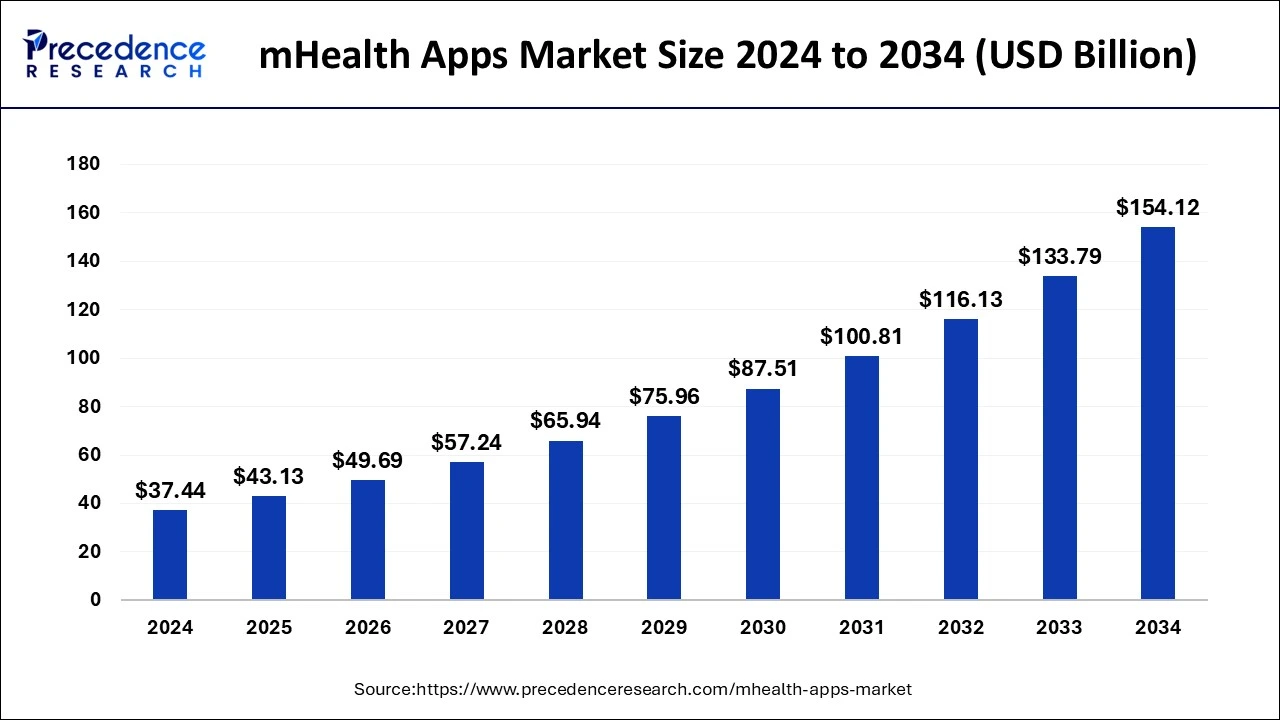The global mHealth apps market is projected to grow from USD 37.44 billion in 2024 to USD 154.12 billion by 2034, with a CAGR of 15.20%

- North America accounted for the highest market share of 38% in 2024.
- The Asia Pacific region is expected to experience rapid growth in the coming years.
- The medical apps segment dominated the market by type in 2024.
- The fitness apps segment is anticipated to grow at a significant rate during the forecast period.
- The Android platform led the market in 2024.
Market Overview
The mHealth apps market is rapidly growing due to increasing smartphone penetration and rising demand for digital healthcare solutions. mHealth apps, or mobile health applications, provide healthcare services, information, and monitoring tools through mobile devices. These apps facilitate remote patient monitoring, teleconsultation, medication reminders, and fitness tracking. The convenience and accessibility of mHealth apps have led to their widespread adoption, with a focus on improving patient engagement, chronic disease management, and preventive care. The integration of advanced technologies such as artificial intelligence, machine learning, and data analytics is enhancing the capabilities of these apps, making them more personalized and efficient.
Drivers
Several factors are driving the growth of the mHealth apps market. The increasing prevalence of chronic diseases, such as diabetes, cardiovascular disorders, and respiratory conditions, has necessitated the adoption of remote monitoring and continuous health tracking, which mHealth apps provide effectively. Additionally, the growing awareness of preventive healthcare and fitness has boosted the demand for health and fitness apps. The widespread availability of affordable smartphones and internet connectivity, coupled with government initiatives promoting digital health, is further fueling market growth. Moreover, the COVID-19 pandemic significantly accelerated the adoption of telemedicine and remote healthcare solutions, highlighting the importance of mHealth apps in managing healthcare delivery.
Opportunities
The mHealth apps market offers numerous opportunities for growth and innovation. One of the key opportunities lies in the integration of artificial intelligence and predictive analytics to enhance personalized healthcare delivery. Additionally, the increasing adoption of wearable devices and IoT-enabled health monitoring systems presents opportunities for real-time health data collection and analysis. The rising interest in mental health and wellness apps is another avenue for growth, as users seek solutions to manage stress, anxiety, and overall mental well-being. Furthermore, the expansion of mHealth services in emerging markets, where healthcare infrastructure is limited, provides an untapped opportunity to address healthcare gaps and improve patient outcomes.
Challenges
Despite the promising growth, the mHealth apps market faces several challenges. Data security and privacy concerns remain a significant issue, as mHealth apps collect sensitive patient information that needs to be protected. Regulatory compliance and adherence to healthcare standards pose additional challenges, as different regions have varying regulations governing digital health solutions. The lack of interoperability and standardization between different mHealth platforms also limits seamless data exchange and integration with healthcare systems. Moreover, user retention and engagement can be challenging, as users often abandon apps if they do not perceive continuous value or encounter usability issues.
Regional Insights
North America dominates the mHealth apps market due to its advanced healthcare infrastructure, high smartphone penetration, and favorable government policies supporting digital health initiatives. The United States leads the region with the highest adoption rates of mHealth apps, driven by the growing demand for telehealth services and chronic disease management solutions. Europe follows closely, with increasing investments in digital health technologies and a focus on improving patient outcomes through remote monitoring.
The Asia Pacific region is expected to witness the fastest growth during the forecast period, owing to the rising adoption of smartphones, increasing healthcare awareness, and expanding internet connectivity in countries like India and China. Latin America and the Middle East & Africa are also gradually embracing mHealth solutions, presenting growth opportunities for market players.
Recent News
- North America
- Europe
- Asia-Pacific
- Latin America
- Middle East & Africa
Ready for more? Dive into the full experience on our website!